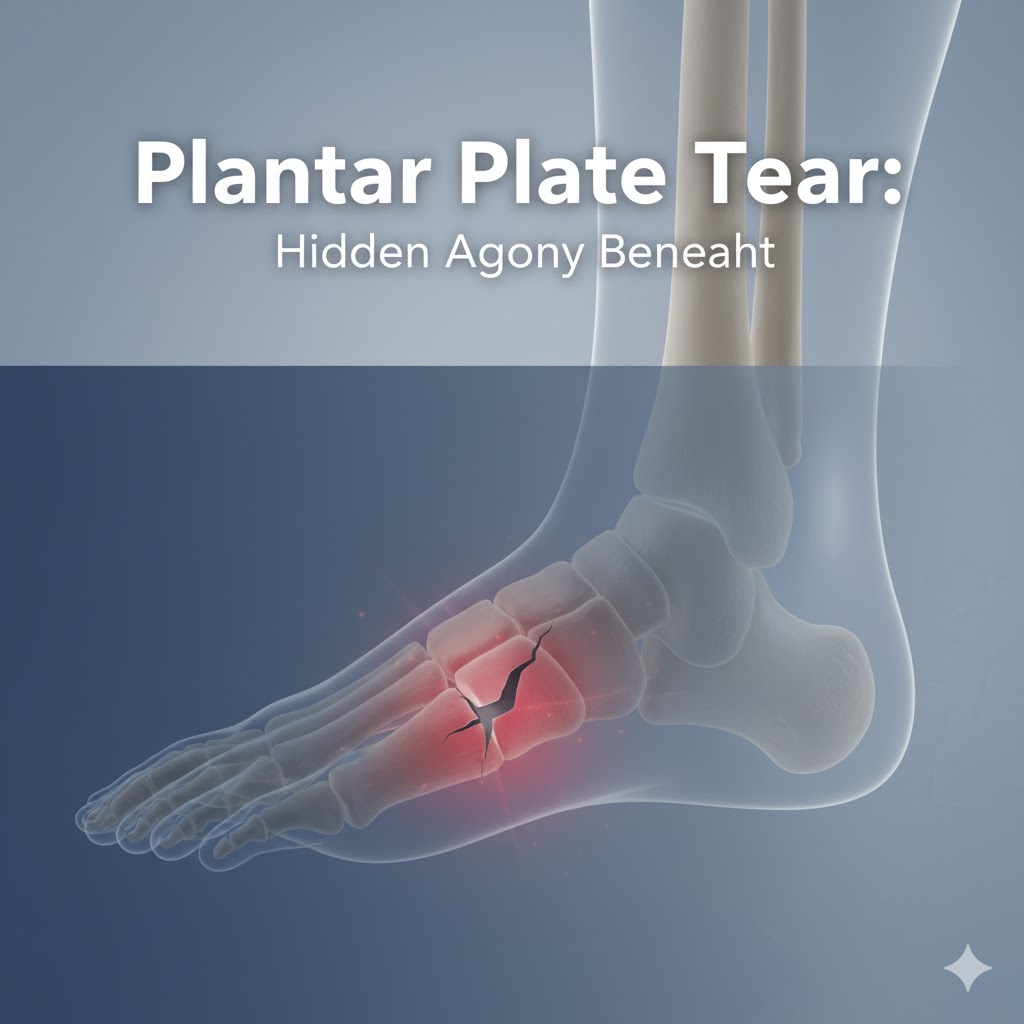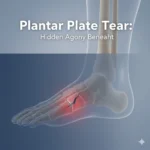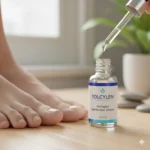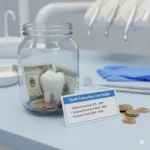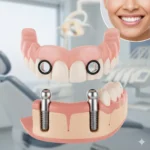Ever felt that stabbing pain under the ball of your foot? Yeah, that one. Most people ignore it. Pretend it’s nothing. But it isn’t. That pain could be a plantar plate tear. And here’s the thing—if you leave it alone, it gets worse. Slowl. Sneakil.
What Exactly Is a Plantar Plate Tear?
Picture the base of your toes. Right under them is a thick ligament called the plantar plate. Its job is simple. Keep your toes stable. Carry your weight when you walk, run, jump, basical live. Tear it? Sudden your toe wobbles. Pain shoots up. Swelling shows. Deformities creep in. That little ligament is way more important than you think.
Who’s at Risk?
Some people walk around like they’re invincible. But certain groups aren’t so lucky:
-
Runners and athletes: pounding the forefoot day in, day out.
-
High heel lovers: those shoes push all your weight onto the front of your foot. Ouch.
-
People with foot issues: hammertoes, bunions. Extra stress. Extra risk.
-
Older adults: ligaments weaken, injuries happen easier.
And honest, even casual walkers can get it. It’s sneaky.
Spotting the Signs
Plantar plate tears don’t scream. They whisper.
-
Sharp pain under the ball of the foot. Especially near the second toe.
-
Swelling at the toe’s base.
-
Toe drifts upward or overlaps its neighbor. Looks weird. Feels weird.
-
Instability. Walking on marbles. Feels like you might fall.
If any of this rings a bell, don’t wait. See someone.
How Doctors Figure It Out
Your foot looks normal? not. They’ll check anyway.
-
Physical exam: poking, pressing, moving toes around. Seeing what hurts.
-
Imaging: X-rays for bones. MRI or ultrasound for soft tissue. Shows the tear.
Early check = better results.
Fixing It: From Simple to Surgery
Conservative Approach
Mild tears? Often they heal without cutting you open:
-
Rest. No sudden sprints.
-
Ice. Reduces swelling. Pain relief.
-
Custom orthotics. Offload pressure. Magic for your toes.
-
Taping. Keeps the toe stable. Prevents worsening.
-
Stiff-soled shoes. No wiggling. No extra stress.
Surgery
Some tears are stubborn. Don’t heal on their own. Surgery comes in:
-
Plantar plate repair: stitch it back. Makes it strong again.
-
Osteotomy: realign bones. Pressure relief.
-
Tendon transfer: move a tendon to help the plate. Fancy stuff.
Recovery and Rehab
This isn’t a “pop a pill” kind of injury. Patience required.
-
Physical therapy. Strengthen muscles. Move joints right.
-
Gradual weight-bearing. Don’t rush it. Step by step.
-
Check-ins. Make sure healing is on track. Adjust treatment.
Avoiding Another Tear
Nobody wants a repeat. Do this:
-
Strengthen feet. Toe exercises. Weird but works.
-
Shoes that fit. Arch support. Cushioning.
-
Don’t overdo it. Gradual increase activity.
-
Fix deformities. Treat hammertoes or bunions. Stress reduction.
Final Thoughts
A plantar plate tear sucks. No way around it. But early treatment helps. Recovery is possible. You can walk, run, live normal again. Don’t ignore that pain. Listen to your feet. They carry you every day. Treat them right.
FAQs: Plantar Plate Tear
1. What is a plantar plate tear?
It’s a tear in the thick ligament under your toes. This ligament stabilizes the metatarsophalangeal joint—the MTP. When it tears, toes can drift. Swell. Hurt. Little things become painful. Walking feels
2. What causes a plantar plate tear?
Repetitive stress. Sudden trauma. High heels. Running. Foot problems like hammertoes or bunions. And aging too. Ligaments weaken. They do. Everyone thinks it won’t happen to them. But it can.
3. What are the common symptoms?
Pain under the ball of your foot. Swelling at the base of a toe. The toe might drift upward. Or overlap its neighbor. You may feel like walking on marbles. Annoying. Frustrating. Hard to ignore.
4. How is a plantar plate tear diagnosed?
Doctor pokes, presses, moves your toes. Looks for pain spots and swelling. X-rays rule out fractures. MRI or ultrasound shows the ligament damage. Early check = better results. Trust me.
5. Can plantar plate tears heal without surgery?
Yes, sometimes. Mild to moderate tears often improve with rest. Ice. Orthotics. Taping. Stiff shoes. It’s slow but it works. Consistency matters.
6. When is surgery necessary?
Severe tears or ones that don’t heal. Surgery can repair the ligament. Sometimes tendons are move. Bones realigned. Fancy stuff. Not fun. But it works.
7. How long does recovery take?
Depends. Mild tears? Weeks. Post-surgery? Months. Gradual return to walking and activity. Don’t rush it. Step by step. Your toes will thank you.
8. Can plantar plate tears prevented?
Yes. Strengthen your foot muscles. Wear proper shoes. Avoid overuse. Treat hammertoes or bunions early. Small steps prevent big pain.
9. Is it common in athletes?
Absolute. Runners. Dancers. High-impact sports folks. Repetitive stress hits the forefoot hard. The plantar plate gets worn. And injuries happen.
.

